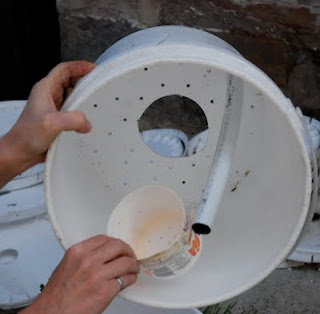Sorry for the extended delay in posting, we decided to go to PEI and environs for an extended holiday which meant beefing up the water system, especially at this time of the year when all the fruit/veg are so thirsty and growing like mad. So Martin, not a plumber by trade but a plumber at heart, set up a permanent watering system that doesn't involve manually dragging the hose to the roof to fill siphon buckets every few days. There is now a hose running up to the roof with a constant water feed and a toilet float in a bucket to keep the water in all the buckets at a constant level. This central bucket it linked with hosing to several other siphon buckets distributed across the roof.
We were gone 2 1/2 weeks so I really wasn't sure what we'd encountered we went went to the roof but we were met wit a bounty of harvest! Between Aug 22 and Sept 10 we collected 10 lbs of Roma tomatoes, many Pink Ladies, Early Girls, Red/Yellow/Ring of Fire peppers. Some of the siphons had lost their prime so a few of the tomato plants had some brown leaves, but overall no major catastrophe. The cucumbers seem to be done though and I'm not sure why since they looked good before we left (i.e. green leaves and some blossoms coming), the zucchini is doing slightly better but seems to have stalled (i.e. still has some blossoms but seems to have slowed down in terms of producing veg.)
We kept the traditional garden going with an automatic timer on a sprinkler and our neighbours were kind enough to continue harvesting cherry tomatoes which are the stalwarts of that garden, they seem to thrive in poor conditions (i.e. low light, little attention).
The weak part of the rooftop system is the siphons which seem to lose their prime occasionally. Next year we will come up with a system that doesn't rely on a siphon but the plumber has some investigation to do to come up with a cost effective solution. There'll be endless evenings trawling the internet during the cold Toronto winter looking for solutions not doubt!
Last Sunday, my niece Nat come over and helped make Hot Tomato Chutney with the Roma tomatoes we harvested. It's an excellent chutney, great on burgers, in a cheese sandwich or served with pork. See recipe at the end of this post, courtesy of Jayne from England who introduced me to this great chutney.
And yes, Martin did see a squirrel, jump from the bicycle shed roof, onto the extension ladder and proceed to climb the rungs of the ladder. Who'd thunk it!
Hot Red Tomato, Pepper and Chilli Chutney
Ingredients:
3 kg red tomatoes, firm5 to 7 large peppers (1.4 kg)
1 kg onions
100g fresh root ginger, grated
or, 1 to 2 ds ground ginger
228g (8oz) dark Muscovado sugar (I just used light brown sugar)
500 ml red wine vinegar
2 tubes tomato puree (double concentrated 200g)
1 ds Halen Môn Anglesey Sea Salt (or what ever kind you have on hand)
1 ts allspice
0.5 ds cumin seeds
1 ds coriander seeds
2 ds mustard seeds
12 whole cardamom pods
12 Hot Mexican red chillies
7 large garlic cloves
ds = dessert spoon ts = tea spoon
Preparation:
Cut up the tomatoes into medium sized pieces (2-3 cm) and place in a large preserving pan. Cut the peppers lengthways in half; remove the pith and seeds before slicing into medium sized pieces, add to the pan. Peel and roughly chop the onions, add to the mixture. Add the sugar and grate the ginger on to the mixture in the pan. Peel the garlic and cut-up into small pieces, or crush the garlic if preferred and add to the mixture.
Squeeze the 2 tubes of tomato puree on to the mixture. Select 12 red chillies and carefully slice, or chop them into small pieces before adding them to the mixture.
Dry-roast the cumin, coriander, mustard, cardamom pods and seeds in a small frying pan for 2-3 minutes. Immediately grind in a pestle and mortar and add all of it (including any husks and pods) to the mixture.
Pour the vinegar over the mixture.
Cooking:
Put on the heat and bring to the boil stirring frequently. The gentle simmer for about 2 hours with the pan lid in place. Stir from time to time. Then remove the lid and allow the liquid to almost evaporate continuing to stir from time to time. When the chutney is thick enough turn off the heat and allow cooling for 5-10 minutes before bottling-up in preheated jars (put in the oven at 120C on a metal tray for 20 minutes). Seal the jars when still hot and store for 6-8 weeks to mature, but it can be consumed in a day or two if you can't wait!. Makes 3 - 4 litres of chutney (10 - 12 jars of 330 ml capacity).











































